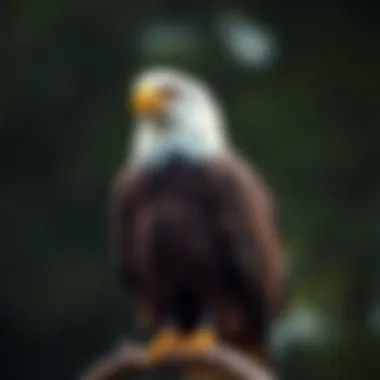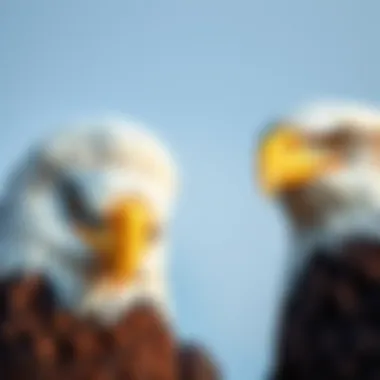Distinct Traits of Male and Female Bald Eagles


Nature Topic Overview
Bald eagles are a sight to behold. They soar high above forests and lakes, capturing the attention of anyone lucky enough to spot them. Yet, many people might not realize that male and female bald eagles are not identical. This article takes you on a journey through the fascinating world of these magnificent birds, diving into their distinct features, behaviors, and roles in nature.
Have you ever wondered why the size of a bald eagle can differ? Or how to tell the male from the female just by looking? Understanding these differences helps us appreciate their biology and the important roles they play in our ecosystems.
As we discuss plumage variations, size differences, and other striking features, you'll gain insight into not only the eagle itself but also the habitats they thrive in. Let's explore the world of bald eagles and unravel their secrets!
Fun Facts and Trivia
Did you know that bald eagles can fly at speeds of up to 30 miles per hour? That’s faster than most kids can run!
- Lifespan: Bald eagles typically live around 20 to 30 years in the wild.
- Vision: Their eyesight is almost 4 to 5 times sharper than that of a human.
- Plumage Coloration: While both genders have the characteristic white head and tail feathers, their youthful counterparts are mostly brown until they mature at about 4 to 5 years old.
Learning these fun facts not only captivates young minds but also ignites curiosity about the natural world. To make it even more engaging, consider adding visuals showing the different stages of a bald eagle's life, from a fuzzy chick to a majestic adult.
Wildlife Explorations
Bald eagles are not the only creatures in their habitat. In the same regions, you might find ospreys or even the elusive golden eagle, each exhibiting unique traits.
Related Species
- Osprey: Known for their fishing skills, these birds have a distinctive white head.
- Golden Eagle: Slightly more diminutive than the bald eagle, they sport golden-brown plumage and are known for their hunting prowess.
Trivia about their Habitat
Did you know that bald eagles build the largest nests of any bird? Some nests can weigh over a ton and be up to 13 feet deep! They are normally situated high above the ground, typically near large bodies of water where they can hunt for fish.
By engaging kids through quizzes or puzzles about these birds and their habitats, we foster a deeper understanding of wildlife and conservation.
Environmental Awareness
The conservation of bald eagles is not just about protecting a species; it’s about preserving the health of our ecosystems. As apex predators, they help maintain the balance in their environments.
It’s crucial for young minds to understand their role in nature. Here are some ways children can actively engage in preservation efforts:
- Clean Up Activities: Organize local cleanups in parks or lakes to prevent pollution.
- Educate Others: Share what they learn about bald eagles and other wildlife with friends and family.
- Plant Trees: Trees provide essential habitats for numerous species, including birds.
These actions not only protect nature, but they also create a sense of responsibility and connection to the environment.
DIY Nature Activities
Encouraging children to get hands-on with nature can be both fun and educational. Here are some simple activities to inspire creativity:
Crafting a Bald Eagle:
- Materials Needed: Cardboard, scissors, glue, and paint.
- Instructions:
- Cut out eagle shapes from cardboard.
- Paint them to resemble a bald eagle.
- Hang them in your room to admire.
Outdoor Explorations:


- Kids can try birdwatching in their local parks. Bring binoculars and a field guide to identify different birds, including bald eagles!
Prelims to Bald Eagles
Bald eagles are more than just striking birds; they represent a blend of history, culture, and the intricate balance of nature. This introduction sets the stage for an exploration into the distinct features of male and female bald eagles, aiming to shed light on their unique characteristics and roles. Understanding these powerful birds not only fosters appreciation but also ignites curiosity in young minds.
The relationship between humanity and bald eagles is steeped in context. This connection serves not just as a backdrop, but emphasizes why learning about these raptors matters. Children, parents, and educators alike benefit from knowledge about their traits and behaviors, encouraging respect for wildlife and fostering responsible stewardship of the environment.
Historical Context
Throughout history, bald eagles have captured the imagination of countless people. The bird was once on the brink of extinction in the United States due to habitat destruction, pesticide use, and poaching. It was during this time that humans recognized the need for change. Conservation efforts began in earnest, with the passing of the Bald and Golden Eagle Protection Act in 1940. This landmark legislation proved crucial in preserving the species as a symbol of freedom, strength, and resilience.
The resurgence of bald eagle populations provides a compelling narrative of recovery. According to the U.S. Fish and Wildlife Service, thanks to conservation efforts, bald eagle numbers have soared from fewer than 500 nesting pairs in the 1960s to over 71,000 today. This comeback story shines a light on the pivotal role humans play in protecting wildlife, inspiring other conservation initiatives.
Cultural Significance
The bald eagle holds deep cultural significance, particularly in American history. Designated as the national emblem of the United States in 1782, it symbolizes ideals like liberty and strength. Native American tribes have revered the bird for centuries, viewing it as a messenger between the earth and the divine.
Bald eagles frequently appear in art, literature, and folklore, serving as a metaphor for courage and hope. Their majestic presence inspires admiration and is a reminder of the natural beauty surrounding us. Children learning about bald eagles often glimpse a broader picture of how nature intertwines with identity, community, and stewardship.
In this way, understanding bald eagles moves beyond mere birdwatching; it cultivates a deeper appreciation of our environment and the shared responsibility we have to protect it.
Basic Physical Characteristics
Understanding the basic physical characteristics of male and female bald eagles is central to appreciating their unique traits and behaviors. The differences in size, feather color, and body structure can impact their interaction with their environment, contribute to their mating rituals, and offer insights into their survival strategies. By recognizing these distinctions, we can grasp how bald eagles thrive in their ecosystems, making it easier to teach young learners about the wonders of nature.
Feather Types and Colors
The first thing that catches people’s eye about bald eagles is their striking appearance. Adult bald eagles have a distinctive look with their white heads and tails, contrasting with their dark brown bodies and wings. This color difference is not merely for aesthetics; it's also tied to their behavior and role in the wild.
Interestingly, female eagles may have slightly duller plumage than males. This isn't just a coincidence; it plays a role in their identity among mates. The purpose? When females are incubating eggs, their less vibrant coloration helps them blend in better with their surroundings, reducing the chance of predation.
"The white feathers make them look majestic, but it’s their coloring that also keeps them safe!"
Moreover, during their first few years, both male and female bald eagles have a different set of feathers. Juvenile eagles boast a mix of brown and white feathers, which gradually shift to the classic adult look as they mature. This transformation is not just about looks, but about providing lessons on adaptability and change, which is crucial for young learners.
Body Structure and Size
When it comes to body size, bald eagles showcase a noticeable sexual dimorphism. Generally, female bald eagles are larger than their male counterparts. In fact, females can weigh up to 25% more than males. This size difference can be significant for several reasons. For one, the larger size of the female allows her to carry and incubate eggs more effectively, contributing to the species’ reproductive success. At the same time, the smaller male can be more agile, which helps in hunting and foraging.
- Male Bald Eagles:
- Female Bald Eagles:
- Average weight: 3 to 4 kg
- Wingspan: 1.8 to 2.2 m
- Average weight: 4 to 6 kg
- Wingspan: 2 to 2.4 m
The wingspan of both males and females is quite impressive, helping them in flight and facilitating their ability to soar over large territories in search of food.
Such differences in size and body structure resonate well with children, offering relatable narratives about strength, agility, and the balance of attributes needed for different roles in the wilderness. Understanding these traits nurtures a sense of curiosity about how life thrives in varied forms, paving the way to a broader appreciation of biodiversity.
Sexual Dimorphism in Bald Eagles
The male and female bald eagles exhibit distinct variations that are not just a treat for the eyes but serve crucial roles in their survival. Understanding sexual dimorphism is fundamental in discerning how these magnificent birds are equipped for their roles in the ecosystem. These avian differences go beyond mere appearance; they influence behaviors, nesting strategies, and hunting techniques, showing how evolution shapes species based on their environmental needs. Understanding these differences allows us to appreciate not only bald eagles but the intricate balance of nature itself.


Understanding Sexual Dimorphism
Sexual dimorphism refers to the differences in appearance between male and female species of the same kind, and bald eagles are no exception. For anyone looking up at these birds soaring through the sky, it’s not always easy to tell them apart just by a glance. However, there are subtle yet significant traits that help in distinguishing between the two.
A few key aspects to consider include:
- Size: Generally, female bald eagles are larger than males—a common thread in many bird species, where females tend to be bigger to better support the requirements of breeding and nurturing young.
- Plumage: While adults of both sexes share similar feather colors, females often appear a bit more robust both in feather size and density.
- Behavioral Traits: Females often exhibit more assertive behaviors during nesting and defensive feeding. This can be closely tied to protecting their young and claiming territory.
Grasping these elements enriches our understanding of their biology and helps foster a greater appreciation for wildlife.
Male vs. Female: Key Differences
When it comes down to the nitty-gritty of differences, let’s break it down further:
- Size Discrepancies: Females generally weigh roughly 25% more, tipping the scales around 10 to 14 pounds compared to males who average about 6.5 to 10.5 pounds. This weight advantage offers females superior resources to incubate eggs and care for hatchlings.
- Beak Size: Males and females possess large, hooked beaks designed for tearing flesh, but females may have slightly larger beaks. This adaptation works in the wild for catching larger prey and dealing with the rigors of feeding offspring.
- Color Indicators: While both genders sport the iconic white head and tail feathers, the males' feathers may show signs of wear earlier on due to differing activity levels during the breeding season.
- Behavioral Nuances: Males tend to be more agile, often exhibiting swooping dives during courtship displays. Females might engage more in nest-building and protection behavior, creating a dynamic visual of their differing roles within their partnership.
"Spotting these differences provides naturalists and enthusiasts with insights into the lives of these majestic raptors."
Understanding these nuances enhances our knowledge about how male and female bald eagles adapt and thrive in the wild, each playing unique roles that contribute to the overall health of their populations.
Comparative Analysis of Male and Female Bald Eagles
Understanding the differences between male and female bald eagles is essential for appreciating their unique roles in nature. Characters of size, behavior, and even their interactions with the environment help paint a complete picture of these magnificent birds. A comparative analysis sheds light on how these differences affect their survival and success as species.
Size Discrepancies
When looking at male and female bald eagles, one can’t help but notice the clear size gap. Generally, female bald eagles are noticeably larger than their male counterparts. This size discrepancy is a classic example of sexual dimorphism, where the two sexes of the same species exhibit different characteristics.
To break it down:
- Females can weigh up to 14 kilograms (around 31 pounds), while males typically range from 3.5 to 6.3 kilograms (8 to 14 pounds).
- In terms of wingspan, females can stretch from 180 to 210 centimeters (about 71 to 83 inches), whereas males usually span 160 to 190 centimeters (63 to 75 inches).
This size difference plays a significant role in their survival strategies. Larger females are often better suited for nesting and raising offspring. Their size may help them defend nests more effectively against predators, a crucial aspect when raising young chicks in the wild.
"Size matters—not only in strength but also in nurturing the next generation of bald eagles."
Behavioral Traits
While size is one piece of the puzzle, behavior further delineates the roles of male and female bald eagles. Observing their behavioral patterns reveals much about their interaction with each other and their environment.
- Mating Displays: Males often engage in elaborate courtship displays. They may perform aerial acrobatics, showcasing their strength and agility to attract a mate. This is particularly vital during the breeding season when finding a partner is critical.
- Nesting Duties: Females typically take on the responsibility of selecting the nest site. They look for locations that can provide safety and shelter for their eggs and eventual eaglets. Males are often tasked with gathering materials to help build the nest, scouting out twigs and other items to ensure it’s sturdy and well-fortified.
- Hunting and Feeding: When it comes to food, males generally handle the bulk of hunting. They venture out farther and are known to catch fish, a staple in the bald eagle diet. The females are, however, not to be overshadowed; they also hunt but tend to partake in scavenging and monitoring their surroundings while rearing their young.
The behavioral traits of male and female bald eagles not only highlight their differences but also their cooperation. Together, they create a balanced ecosystem essential for the species’ longevity.
Reproductive Roles and Responsibilities
Understanding reproductive roles and responsibilities of male and female bald eagles is crucial to grasp the complexities of their social behavior and ecological significance. Their distinct approaches to reproduction greatly affect the survival of their offspring and the overall health of their populations. Knowing how these magnificent birds nurture their young is also a window into their behavior in the wild, helping us appreciate them even more.
Nesting Behavior
The nesting habits of bald eagles showcase a fascinating interplay between both sexes. These birds typically build large nests, often called eyries, which can measure up to 13 feet deep and 8 feet wide. Nests are built in tall trees or on cliff edges, ideally located near water sources for feeding.


- Location Selection: Males usually play a crucial role in selecting the right spot for nesting. They must consider accessibility to food and safety from ground predators.
- Construction: Both genders partake in building. Males typically start off by bringing larger sticks and branches, while females follow up with softer materials, such as grass or moss, to line the nest. This teamwork not only fortifies the structure but also strengthens pair bonds.
- Nesting Season: The nesting season varies depending on locale but usually falls between January and March. These birds return to the same nest year after year, often adding on to it each season. It’s a clear display of dedication to their home, which can be reused for decades.
Female's Role in Incubation
After laying the eggs, which usually number between one to three, females take center stage in incubation. This phase is critical for the eggs' development and requires diligent attention.
- Incubation Duration: Females typically incubate the eggs for about 35 days. During this time, she keeps the eggs warm with her body, often rotating them to ensure even temperature.
- Situational Shift: The female leaves the nest for short breaks but relies on the male to bring food during these periods. The male often takes on the responsibility of hunting while she focuses on the eggs, showing an impressive division of labor.
- Hatching: Once the chicks hatch, they rely on their mother’s nurturing presence for warmth and care. The female stays with the young, offering security and guidance as they begin to explore their surroundings.
Male's Role in Food Provisioning
While females focus on incubation, males undertake the essential task of food provisioning. This role is paramount for the survival of both the young and the chick’s mother.
- Hunting Skills: Males typically have keen hunting skills to catch fish and other prey. Bald eagles are known for their impressive aerial capabilities, swooping down at high speeds to snag fish from the water's surface.
- Territoriality: Males defend their nesting territory fiercely, ensuring ample food sources are available within their proximity. This not only keeps the female fed during incubation but also sets a solid foundation for raising the chicks.
- Bringing Back Meals: Males are known to be quite devoted providers. They often return to the nest with food, making sure the female and the chicks’ needs are met. This behavior strengthens the family’s bond and promotes cohesion within the pair.
"In the wild, the harmony between male and female bald eagles creates a strong family dynamic, vital for their young’s survival."
By understanding these facets of their reproductive roles, we gain valuable insight into the survival strategies of bald eagles. The cooperation between female and male serves not just to ensure the growth of their young but also to maintain their vigour within their ecosystem.
Conservation Status and Efforts
Understanding the conservation status of bald eagles is crucial to appreciating these majestic birds. Once teetering on the brink due to hunting, habitat destruction, and the effects of pesticides, common practices and policies have shifted tremendously over the years. Their recovery represents a significant environmental success story, showing how proactive efforts can turn the tide for wildlife. It's essential to discuss the challenges they face today and the initiatives that have been put in place to safeguard their future, especially as these birds hold considerable ecological value.
Threats to Bald Eagle Populations
Bald eagles face several threats that could compromise their well-being. Notably, habitat loss remains a pressing concern. As urban areas expand, vital nesting and hunting grounds are vanishing, forcing the eagles to adapt to less-than-ideal environments. Furthermore, pollution from industrial runoff contaminates their food sources, which primarily include fish – a staple in their diet.
Major threats include:
- Lead poisoning: Eagles often ingest spent lead ammunition while foraging, which can lead to fatal neurological issues.
- Vehicle collisions: As they hunt or nest near roads, they can become victims of vehicular traffic, putting their lives at risk.
- Climate change: Changes in temperature and weather patterns alter their habitats and food availability, making survival increasingly difficult.
The convergence of these pressures underscores the fragility of bald eagle populations, making awareness and targeted action imperative.
Conservation Programs and Initiatives
Various conservation programs and initiatives have sprung up in response to the plight of bald eagles. One notable effort is the Bald Eagle Recovery Plan, which outlines several strategies aimed at bolstering eagle populations. This plan not only focuses on habitat restoration but also emphasizes the importance of education in local communities.
In addition to this, organizations such as the National Audubon Society and the U.S. Fish and Wildlife Service are actively engaged in monitoring populations and advocating for stronger wildlife protection laws. These efforts have resulted in:
- Banning lead shots in specific wildlife areas.
- Establishing protected zones around nesting sites to minimize disturbance.
- Conducting regular population surveys to assess the health of bald eagle populations.
"Conservation is not only a cause we fight for; it’s an essential element of ensuring the future of bald eagles and the ecosystems they inhabit."
Awareness campaigns aimed at educating the public have also gained traction. With combined efforts from governmental bodies and grassroots organizations, many resources are devoted to conserving these iconic birds. This ongoing commitment highlights how collective action can make a meaningful difference for bald eagles, fostering hope for their future in the wild.
Finale
Understanding the distinct features of male and female bald eagles is far from trivial; it carries significant implications for both conservation efforts and the broader ecological tapestry in which these majestic birds reside. Recognizing the differences in their plumage, size, and behaviors helps paint a clearer picture of their roles in nature.
Summary of Key Points
- Sexual Dimorphism: One striking element is sexual dimorphism, where the physical characteristics of the two sexes differ notably. Females tend to be larger, which is a common trait in many bird species, and their plumage can sometimes appear lighter, especially during breeding season.
- Behavioral Differences: Males and females exhibit different behaviors. The female often takes on a key role in incubation and protecting the nest, while the male primarily focuses on hunting and providing food. Understanding these roles is essential for grasping the dynamics of their partnership during breeding season.
- Conservation Status: Appreciating these differences also underscores the importance of conservation efforts. Bald eagles were once on the brink of extinction, and knowing their habits and needs helps us protect them effectively.
Importance of Understanding Bald Eagle Biology
Grasping the biology of bald eagles nurtures a deeper connection to wildlife and enhances our appreciation for biodiversity. Here’s why this understanding matters:
- Education and Conservation: Teaching children about these differences fosters respect for wildlife and can inspire the next generation of conservationists.
- Ecosystem Roles: Bald eagles play crucial roles in their ecosystem, acting as top predators. Their behaviors help maintain the health of the environments they inhabit.
- Informed Actions: A well-rounded understanding informs our actions to protect eagles and their habitats. It encourages community involvement in conservation initiatives.
"The more we understand these birds, the better equipped we are to ensure their survival for generations to come."







